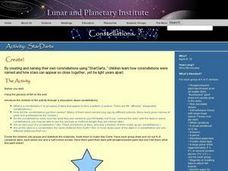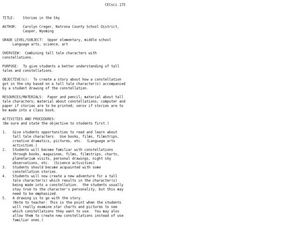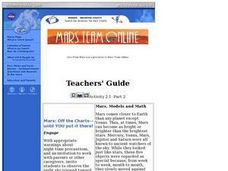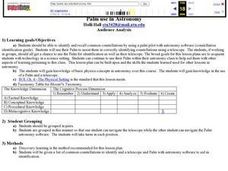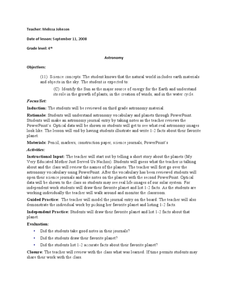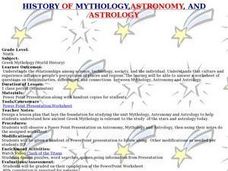Curated OER
Introduction to the Day and Night Sky
Students explore space science by participating in a sky observation activity. In this astronomy instructional activity, students define a list of astronomy vocabulary terms and examine star charts of the four seasons. Students gather...
Curated OER
Our Sky Clock
Students explore space science by completing a worksheet in class. In this astronomy lesson, students discuss and identify star patterns in the night sky and relate these patterns to the approximate time they appear. Students complete an...
Curated OER
Have you seen the man on the moon?
Students study about the phases of the moon and create a picture of the night sky. They use Super print or Kid Pix to create the picture. Students also decide if the picture they have chosen is good for seeing moon and stars or not.
Curated OER
Our Changing View of the Solar System
Students identify and name the eight planets and the five dwarf planets in our solar system. In this space science lesson, students view a slideshow of the planets and label them on an included Solar System chart.
Curated OER
How Hot is that Planet?
In this planet worksheet, students read about finding the temperature of a planet using the distance to its star, its reflectivity and the luminosity of the star. Students use a given equation to determine the surface temperature of the...
Curated OER
Hubble Sees a Distant Planet
In this Hubble telescope worksheet, students solve 4 problems about the image of the distant planet the Hubble telescope discovered. Students determine the distance the planet was from its star in 2006, they determine the planet's...
Curated OER
The Earth, Sun Mood and Stars Unit (Planets too!)
Fifth graders prepare five activities to do then show their energy saving skills. In this investigative lesson students create five projects then participate in an energy saving demonstration.
Curated OER
StarDarts
Students divide into groups of four or five and distribute materials to design StarDarts by drawing and cutting out 6-8 cardstock stars, each about one and a half inches across. They decorate their stars with phosphorescent paint...
Curated OER
Spinning into Space
Students, through hands-on activities, teacher demonstrations, pictures, and informational books, complete a unit on the Earth and its place in the Universe. They make mobiles of the Milky Way and watch demonstrations of lunar and solar...
Curated OER
Auroras
In this aurora worksheet, students read a description of an aurora observed by Captain Standard in 1859. Students interpret the description with a drawing giving as much detail as possible using colored media to capture what they read.
Curated OER
Scavenger Hunt: Who am I?
In this solar system learning exercise, students use an on line source to find the names of the people who discovered the planets, comets, asteroids, black holes and the idea of the big bang theory.
Curated OER
An Introduction to the Night Sky and Movement Astronomy
Basically, this is an interactive exploration of educational astronomy software and an app. Young astronomers discover how the apparent motion of the sky relates to Earth's movements and the position of the observer. It is out of this...
Curated OER
Stories in the Sky
Students discover the concept of combining constellations and tall tales. In this tall tale lesson, students compare constellations to tale tales. They create their own tall tale and constellation.
Curated OER
Mars: Off the Charts--Until You Put It There
Learners explore the night sky and make illustrations which are shared in class the next day. Distinctions are made between the stars and the planets and views of the constellations for the season are made available. The work of early...
Curated OER
Palm use in Astronomy
Students identify and recall common constellations by using a palm pilot with astronomy software. Students will use their Palm to assist them in correctly identifying constellations using a telescope.
Curated OER
Stellar Lunar Curriculum
Students engage in a instructional activity about the moon and three different constellations. They conduct research using a variety of resources. The teacher leads the class with demonstrations and discussion groups. The research is...
Curated OER
Myths and Legends
Eighth graders write a myth about a constellation that is seen from the night sky in South Carolina. They draw a picture of their constellation to attach to their myth. They scan their pictures and type their stories into a web page...
Curated OER
Shadow Know-How
In this fill in the blank worksheet, young scholars identify the names of fourteen constellations by analyzing their outlines in shadow
pictures.
Curated OER
Astronomy
Students explore the rotation of the Earth and observe the shapes of constellations. After discussing how the Earth moves. volunteers use a flashlight and globe to model the movement of the sun-Earth system. Using Digitalis technology,...
Curated OER
Stellar Lunar Curriculum
Students engage in a lesson that covers the concept of different phases of the moon. They name the cycles of the phases of the moon while using flashlights to simulate the light of the sun. They research information about several...
Curated OER
Knowledge Quiz: The Universe
In this universe quiz worksheet, students complete a set of 10 multiple choice questions that cover a variety of concepts about the universe: constellations, black holes, the solar system, etc.
Curated OER
Astronomy
Learners complete a series of activities to better understand space studies. In this space science activity, the teacher is provided with a number of activities for students to complete such as finding words that begin with the prefix...
Curated OER
Scavenger Hunt: Who am I?
In this space science activity, students use the sites listed on the Solar System and Planets page of the Kid Zone to locate the names of the people credited with each discovery. They identify and name 26 different scientists who made...
Curated OER
History of Mythology, Astronomy and Astrology
Ninth graders examine the relationships of science and technology and how it influences people's perceptions of places. In this mythology and astronomy lesson students view a PowerPoint presentation and complete a worksheet.









